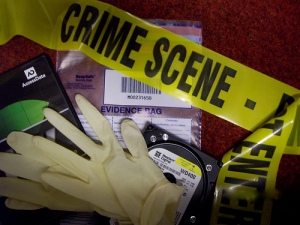Forensics – The Past Meets the Present
It is often thought that police forensics has been a relatively new contribution to interpreting, reconstructing, and solving crimes in our society. Quite the contrary, police forensics, or more accurately described as forensic science, has been a part of history for more than a hundred years.
What is forensic science?
The word “forensic” comes from the Latin word “forensis”, which simply means forum. Today, the area of police forensics is split into two major working categories: criminalistics and forensic science.
Criminalistics is designed to develop and interpret physical evidence; namely, to identify the actual substance, object, or instrument used in the surrounding events of a crime scene. Fingerprints, impression evidence, and trace evidence all fall into this category of expertise. While forensic science, also referred to as forensic medicine or medical jurisprudence, encompasses some of the specialized areas such as serology; the study of blood, pathology; the study of the cause of death, and toxicology; the study of poisons.
The need for forensic science professionals has evolved from the key elements of a crime scene, ideally, linking the victim to the perpetrator and exonerating the innocent. The need for experts to identify and individualize the items of interest from the crime scene is the foundation for solving the crime.
An interesting approach to a crime scene re-enactment is to remember a simple key fact from Nickell and Fisher’s book titled Crime Science, Methods of Forensic Detection, “all objects in the universe are unique”.
Who were our founding fathers of forensic science?
How have they shaped the job responsibilities of our modern forensic science crime busters?
Frenchman Eugene Francois Vidocq was a criminal that turned police detective in the early 1800s. He helped to organize the Surete’, the detective bureau of the French police. Criminal investigation was literally born with his innovative techniques of record keeping, namely a card index system, into a newborn area of criminalistics. Today, Vidocq is celebrated for his pioneering contribution to crime solving by The Vidocq Society, an organization made up of the top forensic professionals who donate their time to solve “cold case” crimes.
* * *
An Austrian well ahead of his time, Hans Gross, who has been referred to as the father of forensic investigation, wrote Handbuch fur Untersuchungsricter in 1893 when translated became Criminal Investigation. The term criminalistics was first used by Hans Gross, and then later only used in print as a title of a book in 1948, An Introduction to Criminalistics. Today, no doubt, the core of our criminal investigation process has advanced due to the groundwork of Hans Gross’ script of criminal investigation.
* * *
The first established police laboratory designed for the examination of crime scene physical evidence was launched by Edmond Locard (photo above) in 1910 in Lyon, France. In the United States, it was not until 1924 that the installation of the first crime lab was established by August Vollmer in Los Angeles, California. Vollmer then gave life to the first School of Criminology at University of California at Berkeley. Today, most law enforcement agencies have a crime lab or access to a facility through a larger or surrounding agency.
* * *
In the United States, Calvin Goddard helps to develop along with others, the comparison microscope. The comparison microscope has had an impact to the evaluation of such items as firearms examination and bullets, and then later tool marks, fingerprints, and various trace evidence.
It has been recognized that the actual forensic science of crime scene investigation has been well established before the obvious technological advancements of the past ten to twenty years. It has been the basic building blocks into the investigation of a crime scene and continues to aid criminal investigators in reconstructing the event and answering the questions of who, what, how, when, where, and why.
* * *
Author Blog: http://authorjenniferchase.com/
Crime Watch Blog: http://emilystonecrimewatch.wordpress.com/
Book & Crime Talk: http://blogtalkradio.com/jennifer-chase
Books: Compulsion Dead Game Dark Mind Silent Partner Screenwriting
Welcome to
CrimeSpace
CrimeSpace Google Search
© 2024 Created by Daniel Hatadi.
Powered by
![]()


You need to be a member of CrimeSpace to add comments!